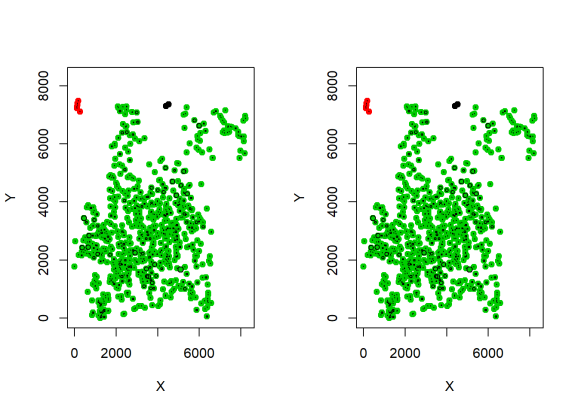From MetaLandSim to igraph and back!
Want to share your content on R-bloggers? click here if you have a blog, or here if you don't.
One of these days I got an email about converting MetaLandSim objects to igraph (or the other way around). One of the reasons I did not use igraph in the first place (leading me to develop MetaLandSim) was that I needed my nodes (the vertexes, using igraph nomenclature) to have fixed positions. These were, after all, spatial graphs! However, in igraph, that’s not straightforward, since it’s main focus is the relations between nodes (or vertexes). Also I needed to have a package tailored to my specific analytical and data requirements.
I wrote this small script with a solution to get graphs across these two packages. The solution is a bit convoluted, so bear with me… maybe one of these days I’ll write a new function and post it here to resolve the issue in a more elegant way.
First let’s start by loading both packages:
library(MetaLandSim) library(igraph)
Convert from MetaLandSim to igraph
Then, we should get a data frame with the data (here, the MetaLandSim sample data):
data(mc_df)
Then, convert to a ‘metapopulation’ class object (beware of the column order, check MetaLandSim manual)
sp1 <- convert.graph(dframe=mc_df, mapsize=8300, dispersal=800) #head(sp1$nodes.characteristics)#check the head of the table
Now, remove species presence/absence information:
rl1 <- remove.species(sp=sp1)
Next, create a table with the nodes information:
df1 <- rl1$nodes.characteristics df2 <- cbind(df1$ID, df1[,-8]) # change the columns order names(df2)[1] <- "ID" #rename ID column
Almost finished… Now, to get data frame with the edges details:
edge_df <- edge.graph(rl=rl1) head(edge_df) #check the top of the table ## ID node A node B area ndA area ndB XA YA XB YB ## 1 1 2 1 0.781 0.079 1420.857 46.725 1248.254 0 ## 2 2 3 1 1.053 0.079 1278.912 52.629 1248.254 0 ## 3 3 5 1 0.079 0.079 1151.337 97.140 1248.254 0 ## 4 4 6 1 0.137 0.079 1295.796 104.839 1248.254 0 ## 5 5 7 1 0.013 0.079 855.687 110.980 1248.254 0 ## 6 6 10 1 0.154 0.079 1367.670 154.928 1248.254 0 ## distance ## 1 178.81561 ## 2 60.90751 ## 3 137.21911 ## 4 115.11498 ## 5 407.95271 ## 6 195.60896
And finally, create igraph object:
g1 <- graph.data.frame(d=edge_df[,-1], directed=FALSE, vertices=df2)
Let’s plot it (it’s a bit messy! too much vertexes):

Convert from igraph to MetaLandSim
Now, having g1, the igraph object we previously created, we will obtain a ‘landscape’ class object (from the package MetaLandSim).
First, convert the igraph graph to a data frame:
df3 <- as_long_data_frame(g1)#each row is an edge
But… we want a data frame in which each row is an node (or vertex in igraph nomenclature). And here each row is an edge (a connection).
So…
l1 <- vertex_attr(g1, index = V(g1))#getting a list of attributes
But… check out the structure (using ‘str’) of this object! In this list each element is an attribute. That’s not what we need exactly!
So…we create the desired data frame, by de-constructing the list:
df3 <- data.frame(matrix(unlist(l1), nrow=length(l1[[1]]), byrow=FALSE),stringsAsFactors=FALSE) names(df3) <- names (l1) head(df3) ## name x y areas radius cluster colour ## 1 1 1248.254 0 0.079 15.8576420089872 1 #FF0000FF ## 2 2 1420.857 46.725 0.781 49.8598055661613 1 #FF0000FF ## 3 3 1278.912 52.629 1.053 57.8947588432262 1 #FF0000FF ## 4 4 6370.625 62.637 0.788 50.0827505547396 1 #FF0000FF ## 5 5 1151.337 97.14 0.079 15.8576420089872 1 #FF0000FF ## 6 6 1295.796 104.839 0.137 20.8826373830461 1 #FF0000FF ## nneighbour ## 1 60.9075086093661 ## 2 120.568429441542 ## 3 54.8721564730237 ## 4 262.650432704765 ## 5 133.177624186648 ## 6 54.8721564730237
But MetaLandSim requires a specific column order (see MetaLandSim manual for details):
df4 <- cbind(as.numeric(df3$name), as.numeric(df3$x), as.numeric(df3$y), as.numeric(df3$areas), 0)
(Note that I needed to use ‘as.numeric’ to convert all columns from character to numeric.)
And now, from data frame to ‘landscape’ object (we’re almost there!):
rl2 <- convert.graph(dframe=df4, mapsize=8300, dispersal=800)
Finally! Remove the species:
rl2 <- remove.species(sp=rl2)
Plot side by side (the MetaLandSim graph we got, after transforming it from igraph, and the original MetaLandSim graph):

The graphs are the equal. No surprise there, that’s what they’re suppose to be!!
I know… this is harder than it should be!
In my defense I can say that MetaLandSim was never intended to be used like this. However, of course, other users have their own requirements and work flows.
I hope this was helpful!
R-bloggers.com offers daily e-mail updates about R news and tutorials about learning R and many other topics. Click here if you're looking to post or find an R/data-science job.
Want to share your content on R-bloggers? click here if you have a blog, or here if you don't.
